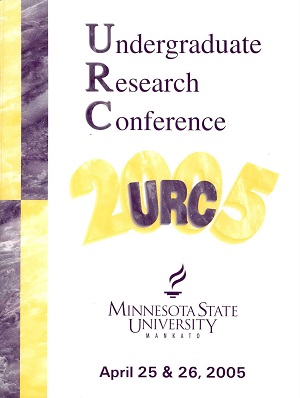The Application of Polymerase Chain Reaction Testing to Identify the Potential Association of Neorickettsiae in Migratory Waterfowl Deaths at Lake Onalaska
Location
CSU 255
Start Date
26-4-2005 10:00 AM
End Date
26-4-2005 12:00 PM
Student's Major
Biological Sciences
Student's College
Science, Engineering and Technology
Mentor's Name
Timothy Secott
Mentor's Department
Biological Sciences
Mentor's College
Science, Engineering and Technology
Description
In the Upper Mississippi River National Refuge at Lake Onalaska, Wisconsin, there has been a significant number of waterfowl (scaup and coot) dying off each of the last two years. A large number of trematodes have been found in the intestines of these birds. Because the rate at which these birds are dying is inconsistent with observed infections, it is possible that another pathogen may be involved. Others have found that Neorickettsia like organism (NRG) in Bithynia snails, which play a critical role in the life cycle of the trematode species isolated from the dead waterfowl at Lake Onalaska. We attempted to identify NRO genetic elements in DNA extracted from duck and trematode tissues. Using polymerase chain reaction designed to amplify 16S rDNA from Rickettsiales, we have thus far identified two samples as suspect for NRO. Continued PCR testing of the samples collected as well as DNA sequencing of amplified products from suspect tissue may yield a determination of whether or not NRO can be implicated in this outbreak of disease.
The Application of Polymerase Chain Reaction Testing to Identify the Potential Association of Neorickettsiae in Migratory Waterfowl Deaths at Lake Onalaska
CSU 255
In the Upper Mississippi River National Refuge at Lake Onalaska, Wisconsin, there has been a significant number of waterfowl (scaup and coot) dying off each of the last two years. A large number of trematodes have been found in the intestines of these birds. Because the rate at which these birds are dying is inconsistent with observed infections, it is possible that another pathogen may be involved. Others have found that Neorickettsia like organism (NRG) in Bithynia snails, which play a critical role in the life cycle of the trematode species isolated from the dead waterfowl at Lake Onalaska. We attempted to identify NRO genetic elements in DNA extracted from duck and trematode tissues. Using polymerase chain reaction designed to amplify 16S rDNA from Rickettsiales, we have thus far identified two samples as suspect for NRO. Continued PCR testing of the samples collected as well as DNA sequencing of amplified products from suspect tissue may yield a determination of whether or not NRO can be implicated in this outbreak of disease.



